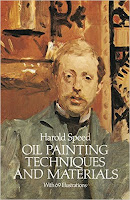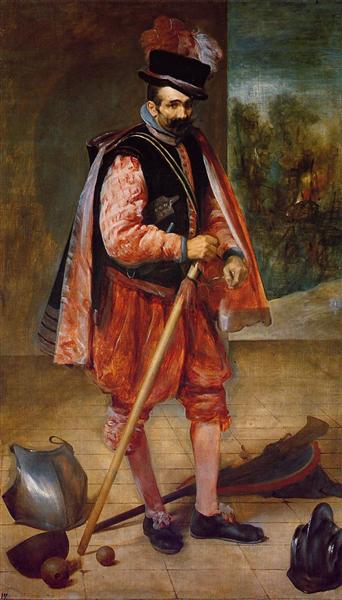 Today we'll continue Chapter 9: "Painting from the Life" from Harold Speed's 1924 art instruction book Oil Painting Techniques and Materials
Today we'll continue Chapter 9: "Painting from the Life" from Harold Speed's 1924 art instruction book Oil Painting Techniques and MaterialsI'll present Speed's main points in boldface type either verbatim or paraphrased, followed by my comments. If you want to add a comment, please use the numbered points to refer to the relevant section of the chapter.
Today we'll cover pages 164-173 of the chapter on "Painting from the Life," where he talks about Velázquez.

1. Velázquez Man with a Ruff
Notes of Speed's main points: Early Velázquez-- Simple handling of tuft of beard. A lot of searching and labor over the edges of the ruff.
V- "hasn't yet arrived at the largeness of perception." I think Speed means his tones are more choppy and modeled on a small scale rather then conceived as larger tonal unit.
2. Velázquez Portrait of young Philip IV
Speed's notes summarized: Head study. Added armor and costume later. Preoccupied with contours of tone masses, but larger effect accomplished. But still tight and "searched out."
3. Pope Innocent X
V. had been traveling in Italy studying painters there. Pope was a difficult subject; Italian painters hadn't succeeded. Painted a study first. Color richer than normal for V. Still interested in edges of tonal masses, but effect is subtler and richer and simpler. Preoccupation with overall visual impression. Very subtle touches to the corners of the eye. Many different brushes in evidence.
4. Court Buffoon (Don Juan de Austria)
Painted to please himself to experiment with new painting ideas. Simple modeling, but good knowledge of skull and structure. Keeps attention on all-embracing unity of impression. "Painted on the same scheme of working from carefully wrought middle tones up to the accents of the lights and the darks, which are the last touches put on."
 |
| Velázquez Philip IV of Spain (detail) |
5. Velázquez Philip IV of Spain
Speed calls this painting the "despair of painters." V had painted the king many times before. Knew his subject. Head well planted in collar. Lack of hard definition throughout. Vertical edge of hair at left and shadow line of eyelid on right echoes vertical structure.
Speed tries to analyze the method V. used: First sitting: rubbed in the head with simple colors, thin paint, and simple tones. Next sitting scumbled with bone brown. Scumbling all over.
6. Speed's allegation that the National Gallery overcleaned the painting.
Speed says that the conservators took away some key glazes and details, and shows comparative photos to demonstrate his charge.
JG again: Velázquez was the object of extreme interest among academic painters both in France and England at the time Speed wrote his book, and Velázquez was much admired when Sargent was studying with Carolus Duran. Much of the academic theory was based on his method. Check out the book The Art of Velázquez by R. A. Stevenson, also from the time of Speed's book. It's available free online at Archive.org.
 Next week— Reynolds and beyond.
Next week— Reynolds and beyond.
-----
In its original edition, the book is called "The Science and Practice of Oil Painting ." Unfortunately it's not available in a free edition, but there's an inexpensive print edition that Dover publishes under a different title "Oil Painting Techniques and Materials
." Unfortunately it's not available in a free edition, but there's an inexpensive print edition that Dover publishes under a different title "Oil Painting Techniques and Materials (with a Sargent cover)," and there's also a Kindle edition.
(with a Sargent cover)," and there's also a Kindle edition.
----GurneyJourney YouTube channel
My Public Facebook page
GurneyJourney on Pinterest
JamesGurney Art on Instagram
@GurneyJourney on Twitter










10 comments:
James, I apologize for coming late to the book club, but I'd love to read all of your wonderful posts about the Speed book. Is it possible for latecomers to click somewhere and see all the book club posts? I see a Book Club "label" on the sidebar, but only the first post comes up. Or is there another way to find the posts? Sorry if I've given you a bothersome task ... thanks for all you do! I love your blog.
Hi, and welcome, Julie. I usually put a link list for all the episodes once the series is finished, as it's a lot of work to do each time. Generally I do new updates every Friday -- though I missed last Friday, so if you scroll back through the "Recent Posts" in the left column of the blog, you can find them all. They all start with the title Harold Speed.
Man, there's nothing like looking at a bunch of Velazquez paintings to fill me with both inspiration and despair. Thanks for this series, James! I've been reading along and have enjoyed your insights and those of other readers, even if I have nothing of consequence to add to the conversation.
Speed's comments about the overzealous conservators cleaning Velazquez's glazes away reminds me of an old Fleischer Brothers cartoon in which Gabby the Lilliputian accidentally cleans a royal portrait with paint remover.
Julie Kessler, type "Harold Speed" in the search box at the upper left, blue bar next to the orange/white Google blogger logo.
They will all come up in search.
I am generally filled more with despair, I admit! Indeed, I am inspired, but Velasquez's skill is so mind blowing (If the term could ever be appropriate in this case) that I feel like I could always just go wrong and never get to a 1/100 of his mastery (also because I am not a full time painter, but just an amateur).
It is nonetheless fascinating to see how a great master like him could change and improve his style depending on external influences.
I am particularly interested in the sessions he could have completed a painting in. I don't think I could attempt a life drawing right now, as the sitter would have to bear my slow hand for at least 10 sessions (if not more) of several hours each
James, what exactly do you suppose Speed meant by calling example 5 the "despair of painters"? That it is painted so incredibly that other painters feel that way? Speed has some brilliant observations, but that one is a bit of a stretch. I have been to the Prado to see the huge collections of Velazquez works… great, but the despair of painters? Or maybe he was referring to how many times poor Velasquez had to paint that face? ;-)
Incredible portrait-scrutiny by Harold Speed!
I would have liked Harold to scrutinize Frans Hals' portraits as well, of whom Max Liebermann is quoted to have said: "The whole imagination of Frans Hals is concencrated in the tip of his brush".
....errhhh...Error!
Frans Hals' tip of the brush should have read:
"concentrated", instead of "concencrated".
Perhaps "consecrated" would be another option for painters alike;-)
Think I prefer "consecrated". The delight I experience when materials are consummately handled can get close to a religious experience. Sadly lacking in most fields of endeavor these days.
The insightful observation re: overcleaning is compelling; I've noticed a few modern instances with suspicion as well, given that the Masters must have known not only how glazes effect nuance, but how all would be unified by the final varnish as well. Varnishes yellow well within the experienced life of a painter, so likely could serve as a final unifying "glaze" expected to remain for a considerable time span. Modern conservators seem bent on reproducing the garish colors we are accustomed to seeing in millions of modern images, and revealing intermediate glazing stages is misunderstood to be revealing the artist's final intent.
The world before the mid-1800's was a dark one, apart from outdoor scenes, and the best painters knew what the work was going to look like for years thereafter.
Post a Comment